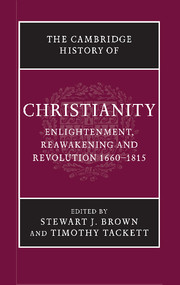Book contents
- Frontmatter
- Introduction
- PART I CHURCH, STATE, AND SOCIETY IN THE EUROPEAN WORLD, 1660–1780
- PART II CHRISTIAN LIFE IN THE EUROPEAN WORLD, 1660–1780
- PART III MOVEMENTS AND CHALLENGES
- PART IV CHRISTIAN DEVELOPMENTS IN THE NON-EUROPEAN WORLD
- PART V REVOLUTION AND THE CHRISTIAN WORLD
- 25 The American Revolution and religion, 1765–1815
- 26 Christianity and the campaign against slavery and the slave trade
- 27 The French Revolution and religion to 1794
- 28 The French Revolution and religion, 1795–1815
- 29 Movements of Christian awakening in revolutionary Europe, 1790–1815
- Chronology
- Bibliography
- Index
- References
28 - The French Revolution and religion, 1795–1815
from PART V - REVOLUTION AND THE CHRISTIAN WORLD
Published online by Cambridge University Press: 28 March 2008
- Frontmatter
- Introduction
- PART I CHURCH, STATE, AND SOCIETY IN THE EUROPEAN WORLD, 1660–1780
- PART II CHRISTIAN LIFE IN THE EUROPEAN WORLD, 1660–1780
- PART III MOVEMENTS AND CHALLENGES
- PART IV CHRISTIAN DEVELOPMENTS IN THE NON-EUROPEAN WORLD
- PART V REVOLUTION AND THE CHRISTIAN WORLD
- 25 The American Revolution and religion, 1765–1815
- 26 Christianity and the campaign against slavery and the slave trade
- 27 The French Revolution and religion to 1794
- 28 The French Revolution and religion, 1795–1815
- 29 Movements of Christian awakening in revolutionary Europe, 1790–1815
- Chronology
- Bibliography
- Index
- References
Summary
Between 1795 and 1815, France underwent astonishing political changes as Revolution gave way to empire-building, followed by military collapse and the Restoration of the monarchy. The political experimentation of the revolutionary and Napoleonic eras precipitated momentous religious transformations. By 1794, the radical revolutionaries had literally attempted to ‘de-Christianize’ France by closing down churches, forcing priests to resign or emigrate, and inventing new republican cults to replace Christianity. Over the next twenty years, as Catholics struggled to restore religious practice, France’s leaders worked to define a new relationship between nation and religion. In the later years of the Revolution, the Directory (1795–99) experimented with separating church and state yet continued to view Christianity as potentially subversive and to pursue anticlerical or de-Christianizing policies. When Napoleon came to power, he negotiated a new settlement that re-established Catholicism as the ‘religion of the majority of the French’ and sought to make it dependent upon the state. This era also demanded flexibility from the nation’s some 650,000 Protestants and 50,000 Jews. They welcomed the legal recognition of rights brought by the Revolution, but also strove to adapt to fluctuating politics, as the revolutionary assault on religious practice gave way to intermittent toleration and then new oversight by the state. Ever ambitious, when he built his empire, Napoleon also exported a controversial set of religious policies, such as appropriating church lands, streamlining worship, increasing state surveillance of religion, and instituting religious toleration. Focusing primarily on France and then on the empire, this chapter explores the creative adaptations of laity and clergy to this era of political turmoil.
- Type
- Chapter
- Information
- The Cambridge History of Christianity , pp. 556 - 574Publisher: Cambridge University PressPrint publication year: 2006



